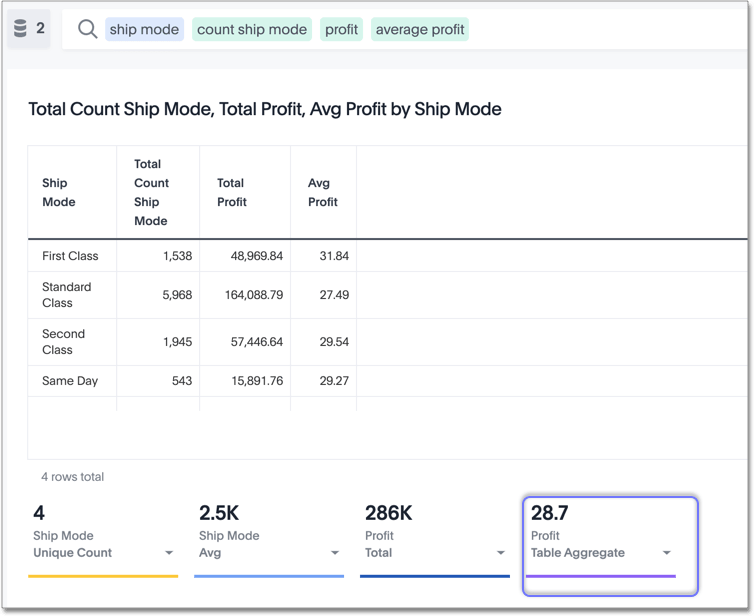Results that are tables
Tables display your answer in a format similar to an Excel spreadsheet.
In the table view, your search identifies attributes and/or columns, and presents them as a table.
ThoughtSpot aggregates the results based on the level of aggregation that you specify in the search.
For example, if you only type revenue, you see the total sum of revenue as a single number.
If you include the keyword monthly, the results are broken down by month.
From the column header, you can rename the column, or sort or filter the column.
You can rearrange the column order of your table by dragging and dropping the columns, either from the table itself or from the Edit table: Configure menu.
You can also change the column widths.
Rearrange column order
You can rearrange the column order of your table after adding all of your search terms.
To rearrange the column order:
-
While viewing your answer as a table, click the column header you would like to move.
-
Drag it across to its new position.
You can also rearrange the column order from the Edit table: Configure menu.
Click the edit table configuration icon ![]() .
Drag and drop the attribute or measure that you would like to move to a new position.
The order of columns in the Configure menu reflects the column order of the table.
.
Drag and drop the attribute or measure that you would like to move to a new position.
The order of columns in the Configure menu reflects the column order of the table.

Resize column widths
You can resize the column widths of your table after adding all of your search terms. Any adjustments you make to the column widths of your table are saved when you pin the table to a pinboard. To resize the column widths:
-
While viewing your answer as a table, hover over a column border in the column header row.
-
Click and drag the border to create your preferred column width.
Clip or wrap text
You can clip or wrap long text in a table cell, or on a table header. You can configure clipped or wrapped text for the entire table, or for each column individually.
When you clip long text, the table cells show only the beginning of the text. The rest appears if you increase the column width.
When you wrap long text, the table shows all the text in its cells by increasing the number of lines in the cells.
To clip or wrap text for the entire table, click the edit table configuration icon ![]() .
Select Settings.
Under text wrapping, choose wrap or clip.
.
Select Settings.
Under text wrapping, choose wrap or clip.
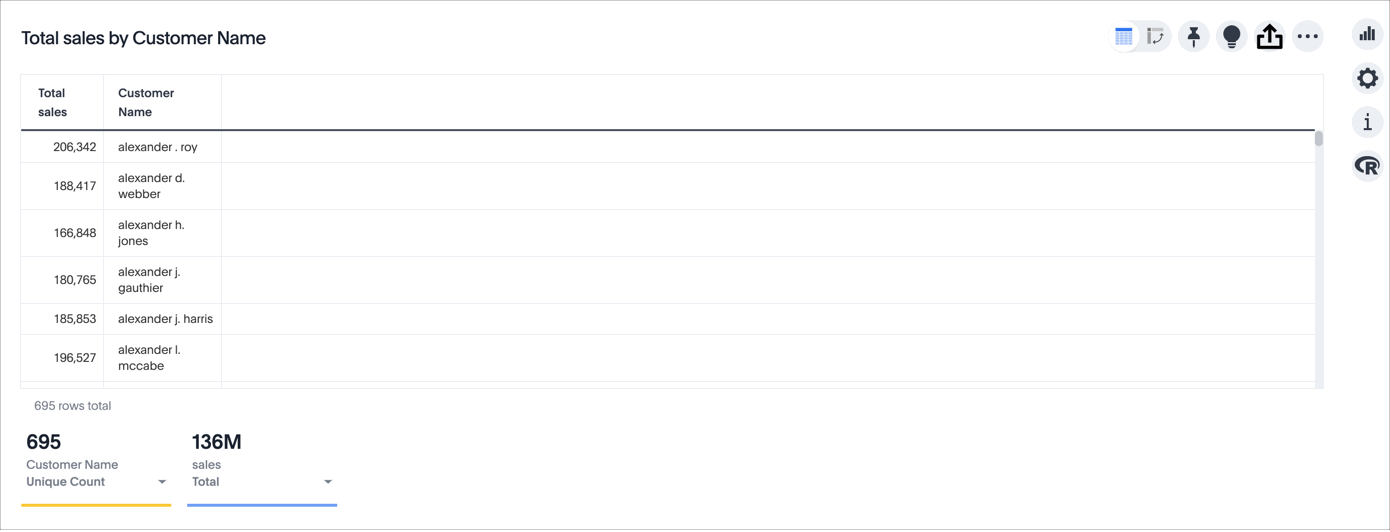
To clip or wrap text for each column individually, hover over the column name and click the more options menu icon ![]() .
Select text wrapping, and choose wrap or clip.
.
Select text wrapping, and choose wrap or clip.
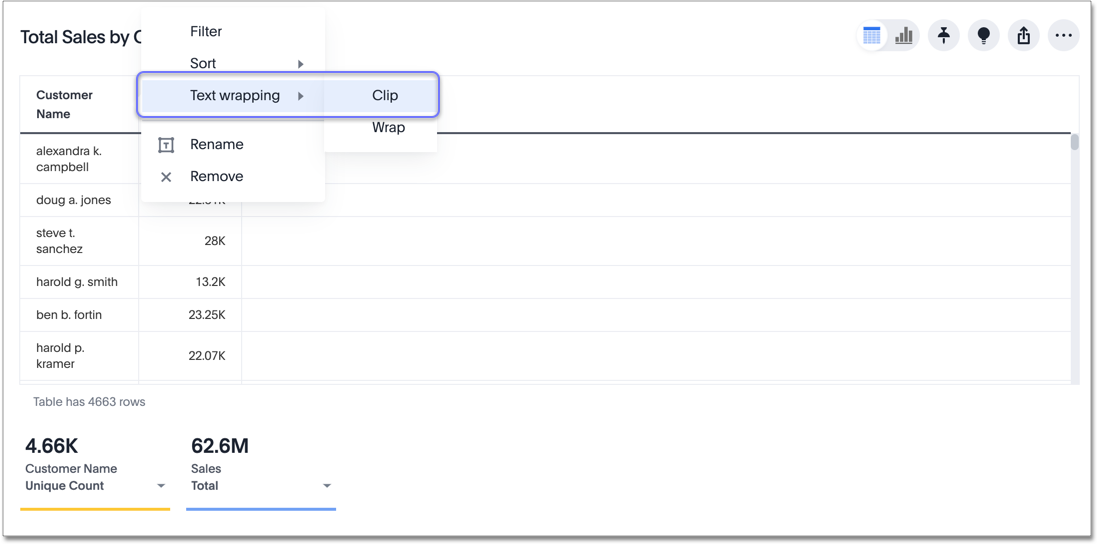
Number formatting
You can format the numbers in any table column based on a measure. This functionality allows you to change the category (number, percentage, or currency), units (auto, none, thousand, million, billion, or trillion), or method of writing negative values (-1234, 1234-, or (1234)).
To change the number formatting:
-
Click the edit table configuration icon
 to the upper right of your table.
The Edit table panel appears, on the Configure menu.
to the upper right of your table.
The Edit table panel appears, on the Configure menu. -
Select the measure you want to format the labels of.
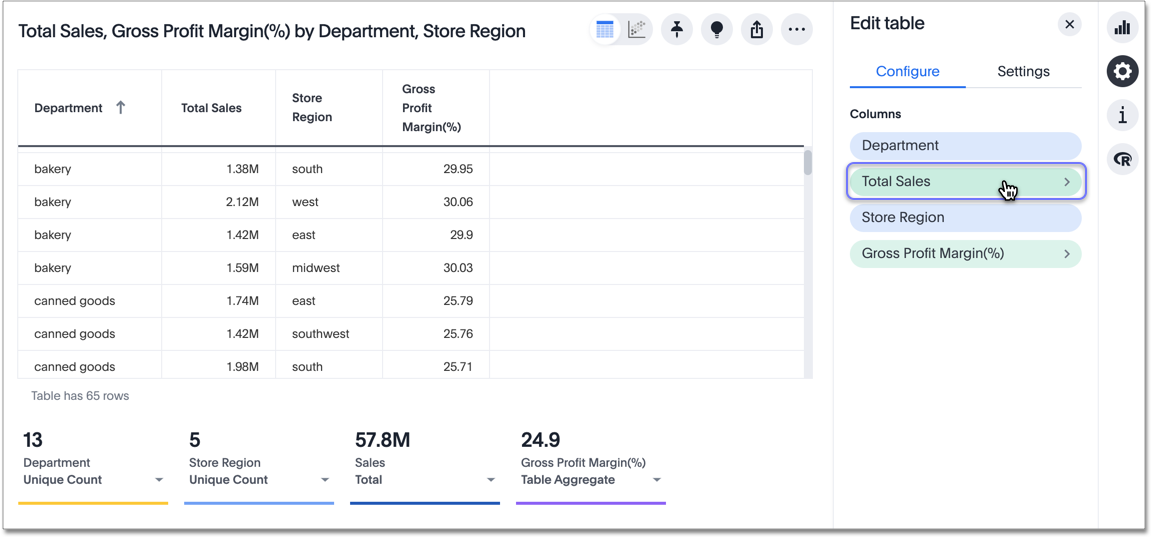
The Edit panel for that column appears.
You can also reach this panel from the more icon that appears when you hover over a column name:
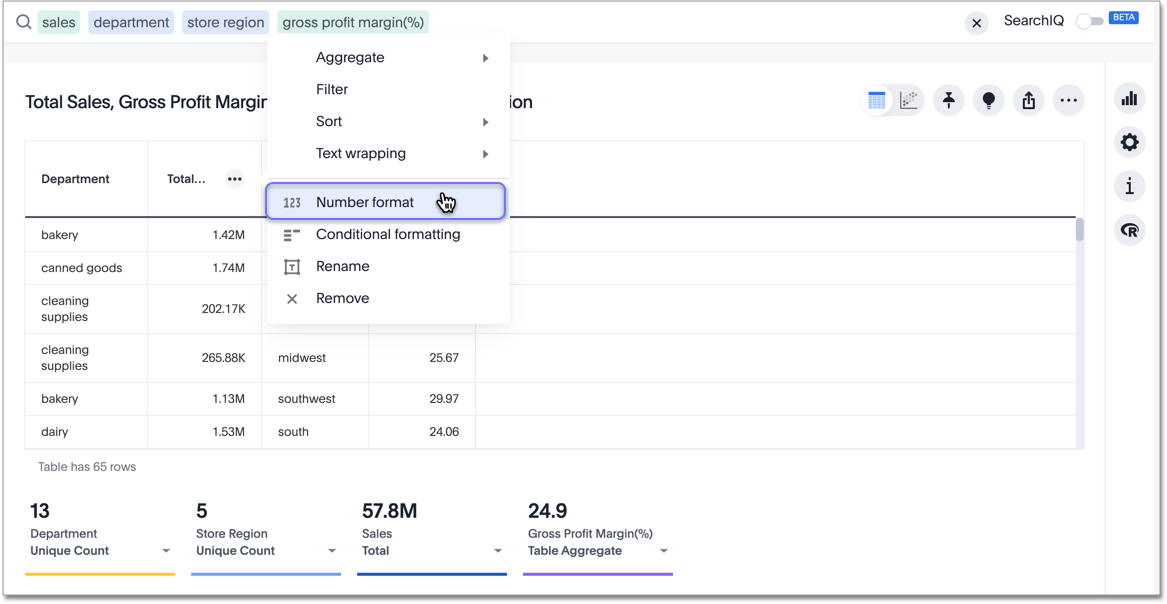
On the table, the column that you are editing is highlighted in a blue box.

-
Under number formatting, you can edit the category, units, or method of writing negative values. Click the dropdown menus to select new values.
-
Specify a category: number, percentage, or currency. If you select currency, you can select the type of currency: USD, AUD, EUR, and so on. If you do not pick a category, ThoughtSpot automatically picks the best category for your data.
-
Specify units: Select none to see your data down to two decimal points, for example, or select millions to see labels rounded to the millions. If you do not specify units, ThoughtSpot automatically picks the best units for your data.
Depending on the unit, you can also specify the number of decimal places, and remove or include the thousand separator.
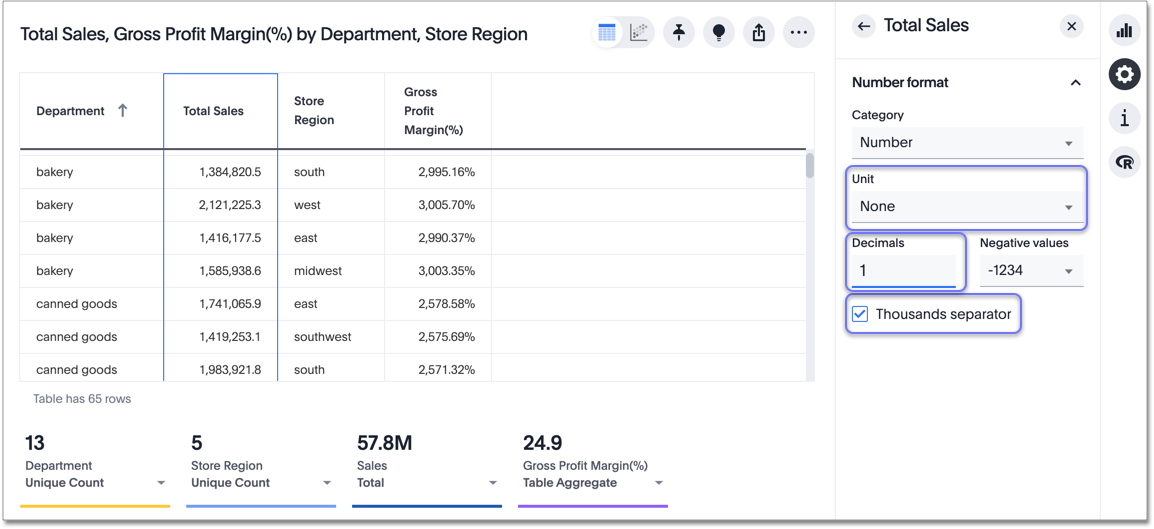
-
Specify the method for writing negative values: -1234, 1234-, or (1234). The default is -1234.
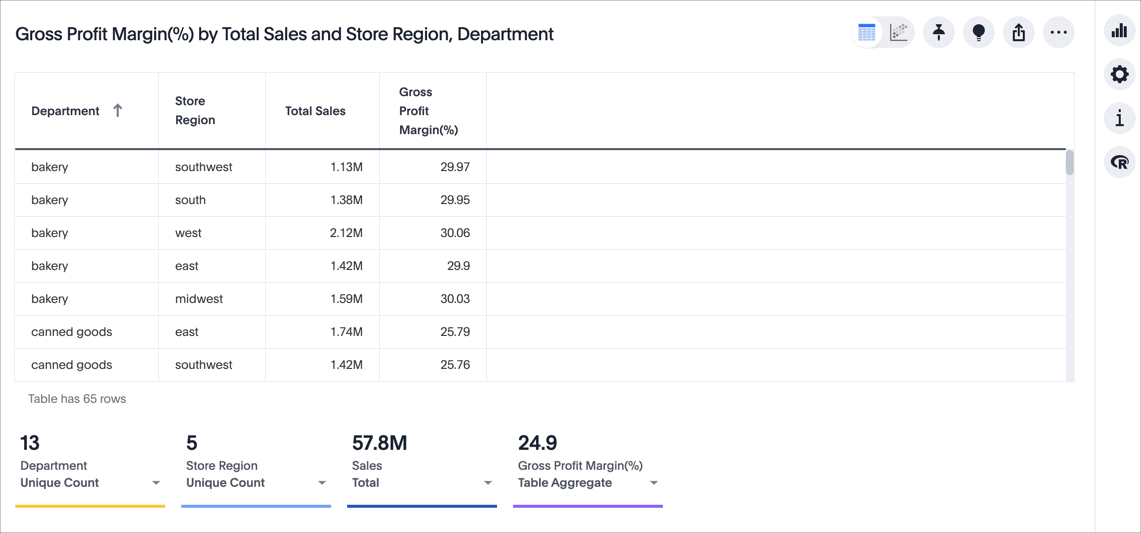
Sort columns
You can sort a table by column values by clicking on the column title.
If you hold down the SHIFT key, you can sort on multiple column titles at a time.
This is especially useful for date columns.
For example, if you search for sales by week and by quarter, and just sort the quarterly column, the weeks are not in order:
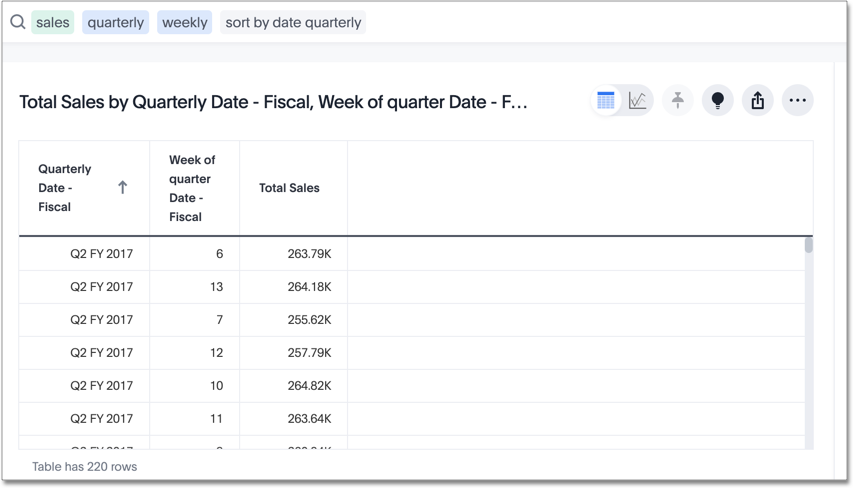
If you press SHIFT and then click on the weekly column header, the weeks are in order, by quarter:
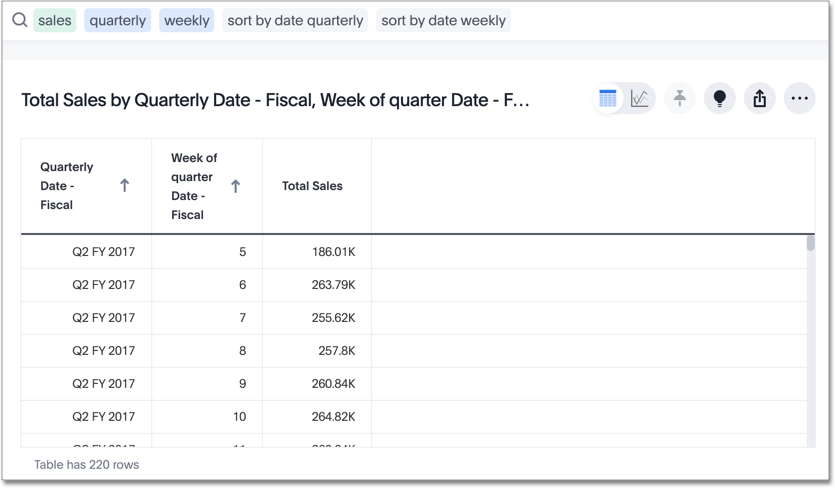
You can achieve this from the search bar, as well, by adding sort by date quarterly and sort by date weekly.
| This same functionality is available on tables you see elsewhere in ThoughtSpot. For example, a table in the Data page is also sortable in this manner. |
Table footer
Tables automatically have footers that tell you the number of rows the table has. You can enable or disable this footer from the Settings menu.
-
Click the edit table configuration icon
 to the upper right of your table.
The Edit table panel appears, on the Configure menu.
to the upper right of your table.
The Edit table panel appears, on the Configure menu. -
Select Settings.
-
Select table footer to enable or disable it.
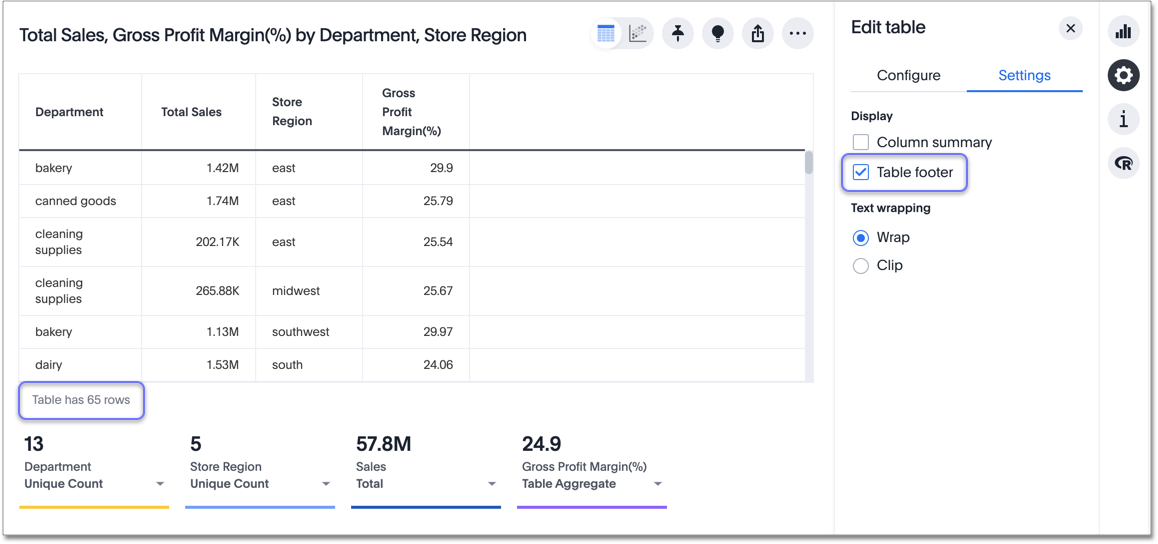
Column summaries
For columns with numeric information, you can turn on column summaries that display column totals.
-
Click the edit table configuration icon
 to the upper right of your table.
The Edit table panel appears, on the Configure menu.
to the upper right of your table.
The Edit table panel appears, on the Configure menu. -
Select Settings.
-
Select column summary to enable or disable column summaries for your table.
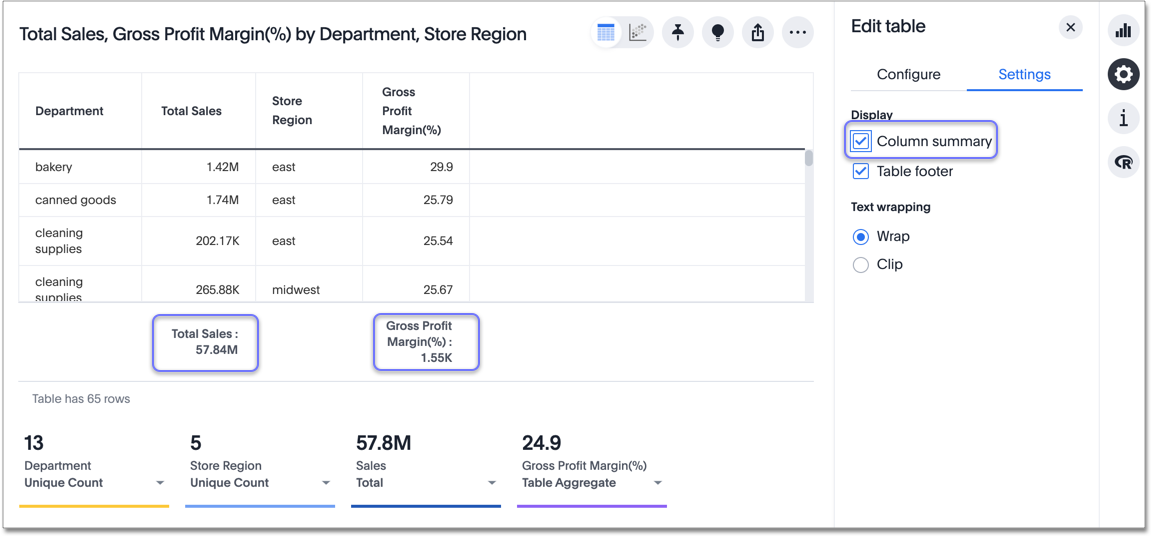
Column summaries are not available for tables with more than 1000 rows.
About headlines (summary information)
Headlines display summary information of a table result. Headlines contain summary information for each column of a table. They appear at the bottom of the table in individual boxes.
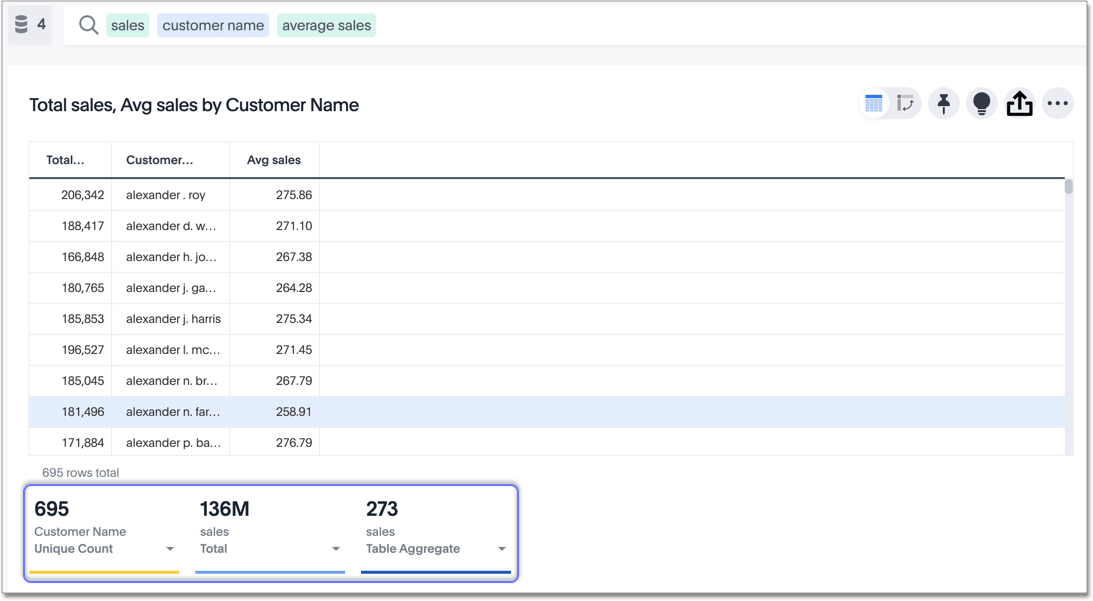
ThoughtSpot automatically creates up to 20 headlines for each table. Your ThoughtSpot configuration can be changed to accommodate more if needed. Headlines are not available for tables with more than 15000 rows, unless the data comes from an Embrace connection.
You can modify how you’d like the value to be displayed by clicking the dropdown on a headline and selecting a different type of aggregation. The usual available aggregations are total, average, standard deviation, variance, minimum, and maximum. There are also unique count and total count values available for the appropriate columns.
To add a headline to a pinboard, hover over the headline and click the Pin icon.

You can decide whether or not to display headlines in your table results.
To customize headlines, click the ellipsis icon ![]() and select Customize Summaries.
and select Customize Summaries.
Table aggregate headline
The Table Aggregate headline option is available when an aggregate function is used either through a formula or a search bar query like average of a measure. It recalculates the function for the entire table. In such cases, Table Aggregate is shown by default in a headline under the table, instead of the “Avg” option, which does a second level of aggregation on top of the existing aggregation.
In the following example, the table aggregate is shown as a result of the Average Profit formula sum ( profit ) / count ( ship mode ) which divides the total profit of each ship mode by the sum total count for that ship mode.
ThoughtSpot recalculates that function for the entire table, taking the sum total profits of all ship modes and dividing it by the sum total count of all ship modes.
Here, that results in a table aggregate average profit of 28.7.
The average headline option, by comparison, sums the average profit for all ship modes and divides it by the number of ship modes (4), providing a less accurate average.
